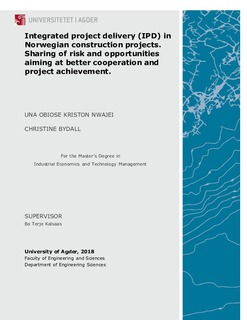| dc.contributor.author | Nwajei, Una Obiose Kriston | |
| dc.contributor.author | Bydall, Christine | |
| dc.date.accessioned | 2018-10-08T11:00:14Z | |
| dc.date.available | 2018-10-08T11:00:14Z | |
| dc.date.issued | 2018 | |
| dc.identifier.uri | http://hdl.handle.net/11250/2566837 | |
| dc.description | Master's thesis Industrial Economics and Technology Management IND590 - University of Agder 2018 | nb_NO |
| dc.description.abstract | In the architecture, engineering and construction (AEC) industry projects are often temporary in nature and are often characterised as PBO project-based organisations. Each project chooses a number of strategies which makes up a project development model. Traditionally models have focused on transactional contracting between actors in the value chain which opens up the way, for sub-optimisation and risk aversion as the common challenges. In such circumstances, each actor has a different perception of the aim and the success of the project, and so try to find ways to take the lowest risk and gain the most profit coupled with optimising their own interests.
Based on the highlighted problem the study aims to investigate of the research is to examine Integrated project delivery (IPD) in Norwegian construction projects. Sharing of risk and opportunities aiming at better collaboration and project achievement.
The thesis aims at testing the differences between IPD and alternative implementation models. Hence this thesis attempts to answer the following propositions:
• Proposition one states that IPD provides less scope for sub-optimisation and opportunistic behaviour between companies in the value chain.
• Proposition two states that IPD provides better conditions for unified solutions (swapping) than traditional contracts.
• Proposition three states that IPD safeguards quality and customer value in a better way than alternative implementation models while maintaining constructability.
• Proposition four states that IPD, in combination with TVD, provides better framework conditions for continuous improvement and innovation compared to a Design Build model.
Furthermore, this case study answers the propositions by collecting data composed mainly of the documents, survey and interviews which were analysed using the framework method.
Based on analysed content the findings show that IPD provides helps to alleviate the characteristic problems in the AEC industry and how this have changed using IPD. These problems come from a lack of quality, lack of collaboration, opportunism, lack of customer value and a lack of innovation. By using a critical realist perspective, one can identify the influencing mechanisms. | nb_NO |
| dc.language.iso | eng | nb_NO |
| dc.publisher | Universitetet i Agder ; University of Agder | nb_NO |
| dc.rights | Attribution-NonCommercial-NoDerivatives 4.0 Internasjonal | * |
| dc.rights.uri | http://creativecommons.org/licenses/by-nc-nd/4.0/deed.no | * |
| dc.subject | IND590 | nb_NO |
| dc.title | Integrated project delivery (IPD) in Norwegian construction projects : Sharing of risk and opportunities aiming at better cooperation and project achievement | nb_NO |
| dc.type | Master thesis | nb_NO |
| dc.subject.nsi | VDP::Teknologi: 500::Bygningsfag: 530::Bygg-, anleggs- og transportteknologi: 532 | nb_NO |
| dc.subject.nsi | VDP::Samfunnsvitenskap: 200::Statsvitenskap og organisasjonsteori: 240::Offentlig og privat administrasjon: 242 | nb_NO |
| dc.source.pagenumber | 169 p. | nb_NO |

